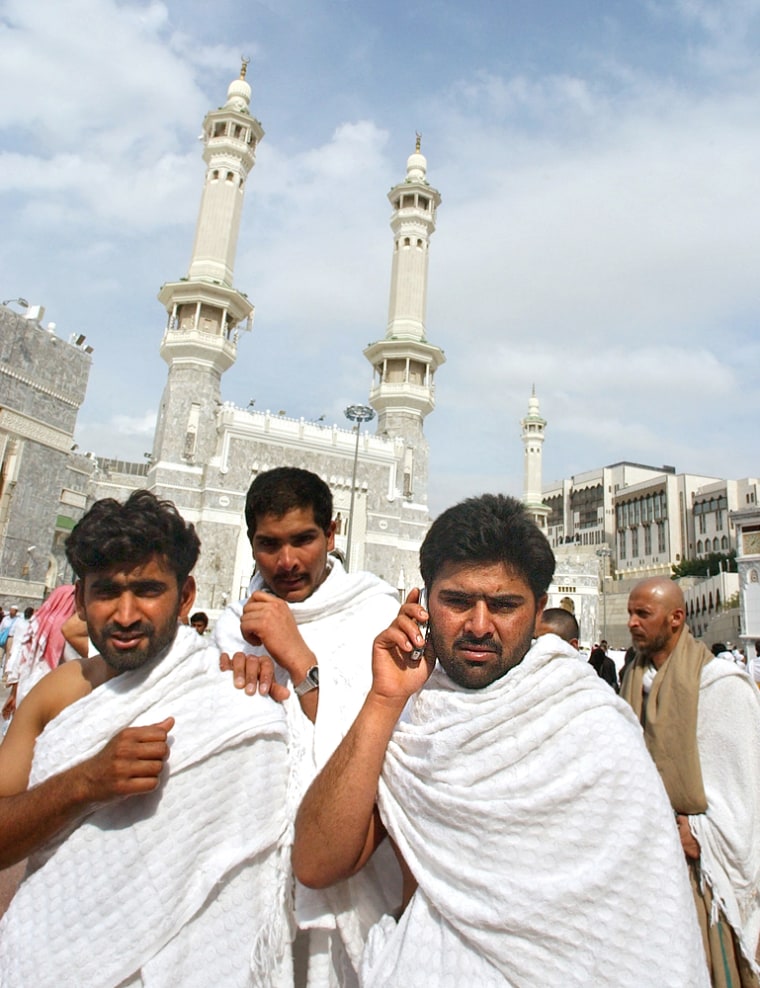Modern technology has changed the way Muslims experience the hajj pilgrimage, a rite required of able-bodied faithful who can afford it at least once in a lifetime. It has also perhaps changed the way they experience being Muslims, as Islamic militants have popularly seized on the Internet as a tool for publicizing their extremist, often violent, version of the religion.
Dressed in a seamless white robe, Algerian pilgrim Tayyeb Bouguettaya circled the Kaaba several times Monday with a prayer booklet in one hand and a mobile phone in the other, reciting religious mantras in unison with his wife a continent away.
"This is the last tawaf (round). Now recite with me, 'In the name of Allah, Allahu Akbar,' "an overwhelmed Bouguettaya, 30, said to his wife, Mina, as he began his final counterclockwise circuit around the sacred black cubic structure.
Outside the holy Kaaba, which Muslims around the world face in prayer five times a day, Bouguettaya was thrilled to have had the technology to share his pilgrimage with his wife, who stayed at home in Algiers.
"I am so happy, it felt like both me and my wife were facing Allah together," Bouguettaya said, standing in front of Islam's holiest shrine.
Moments later, his Nokia mobile phone rang again. "It's my business contact in China," said the electronics dealer with a smile. "I'll e-mail you a little later," he said to the caller, and then returned to his rituals.
Nearby, several other mobiles were ringing, one of them to the tune of pop star Michael Jackson's "Beat It."
Prepaid mobile phone chips are selling easily for 125 riyals (US$33), and Internet cafes are a flourishing business in this holy city.
Digital photos e-mailed home
Outside the Grand Mosque, pilgrims were clicking digital photos to later e-mail home.
"It's my first time using the Internet during the pilgrimage, but it helps me mix work and worship," said Bayo Salau, a 38-year-old businessman from Lagos, Nigeria, who was e-mailing his hajj reflections to his wife from a hotel computer.
But Salau acknowledged that though modern communications were "a blessing," there was a negative side.
Dozens of Islamic Web sites have been launched in recent years, many of them reflecting on the punitive or violent side of the faith followed by the world's 1 billion Muslims. Some are chat-based, allowing for a dialogue about the religion, but many take a militant stance, advocating violence against Westerners in Islamic countries, promoting holy war and boasting of attacks.
"You don't want to get too carried away with this stuff, there's a lot of bad things out there," Salau said, referring to pornography and also violent footage of beheadings and other violence posted by Islamic extremists.
Pilgrim and cleric Sheik Armiyawo Shaidu, 47, of Accra, Ghana, agreed, saying the extremists have taken better advantage of technology than moderate Muslims.
"This kind of advancement in communication has provided a very unnecessary but prominent platform to the extremists who are sending across negative messages that is not only harming people but also our peaceful religion," Shaidu said, referring to the violence in Iraq.
"These people (terrorists) have successfully used these tools to confuse the minds of Muslims who are open to extremist views," he said adding that most modern Muslims were "voiceless."
"I think we need a more pro-active approach to the problem and plan ahead of time to beat them to their own game," he said.
